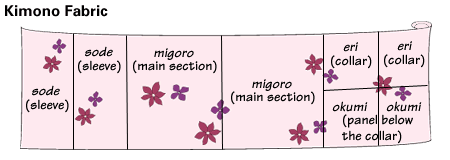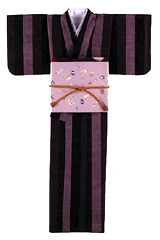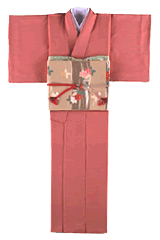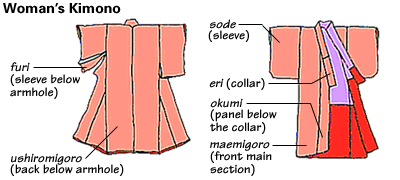|
|
The method used to make kimonos is unique. A piece of fabric 12 to 13 meters (39 to 43 feet) long and 36 to 40 centimeters (14 to 15 inches) wide is cut into eight pieces. These pieces are then sewn back together to create the basic form of the kimono. All of the fabric is used; none is thrown away. Most often, the fabric used is silk, but yukata (informal summer kimonos) are often made of cotton. The use of eight separate panels makes it easy to take the kimono apart in order to replace or repair old, faded, or damaged panels of fabric.
The advantage of fabric with color woven in is that the color goes all the way through, so if the front of the fabric fades, you can flip it over and use the other side. The advantage of dyed fabric is that if the color fades, it is easy to apply new color.
|
|
Photos (from top) : This tsumugi kimono is made with woven color; a dyed kimono known as iromuji. (© Yoshiaki Yamamoto) |

 Kimonos
get their colors in one of two ways: The fabric is woven from different
colored threads; or the woven fabric is dyed. One example of kimono
fabric with the color woven in is oshima-tsumugi, a fabric made
on the island of Amami-Oshima south of Kyushu. This fabric is strong
and has a gloss to it. Another example is yuki-tsumugi, made
in the city of Yuki, Ibaraki Prefecture; this fabric is said to be so
sturdy it lasts 300 years.
Kimonos
get their colors in one of two ways: The fabric is woven from different
colored threads; or the woven fabric is dyed. One example of kimono
fabric with the color woven in is oshima-tsumugi, a fabric made
on the island of Amami-Oshima south of Kyushu. This fabric is strong
and has a gloss to it. Another example is yuki-tsumugi, made
in the city of Yuki, Ibaraki Prefecture; this fabric is said to be so
sturdy it lasts 300 years. Dyed
kimonos start with white woven fabric, which then has a design drawn
or embroidered onto it. This technique produces vividly colored fabrics.
One example of dyed fabric is kyo-yuzen, which is made in Kyoto
and is characterized by elaborate, lavishly colored designs. Another
example is kaga-yuzen, produced in the city of Kanazawa. kaga-yuzen
is characterized by realistic images from nature. (The word yuzen
is the name for the stencil resist dyeing technique and the fabric it
is used to create.)
Dyed
kimonos start with white woven fabric, which then has a design drawn
or embroidered onto it. This technique produces vividly colored fabrics.
One example of dyed fabric is kyo-yuzen, which is made in Kyoto
and is characterized by elaborate, lavishly colored designs. Another
example is kaga-yuzen, produced in the city of Kanazawa. kaga-yuzen
is characterized by realistic images from nature. (The word yuzen
is the name for the stencil resist dyeing technique and the fabric it
is used to create.)